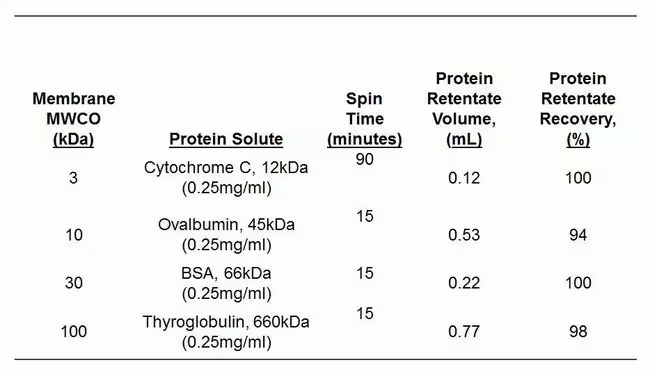
Quickly concentrate proteins and biological samples with Thermo Scientific Pierce Protein Concentrators PES (polyethersulfone), which are disposable ultrafiltration centrifugation devices that enable fast sample recovery and a short processing time. These concentrator columns can be used with standard microcentrifuge equipment, and samples can be collected without the need for invert spinning. Samples can be concentrated with or without desalting. These concentrators have a molecular weight cutoff (MWCO) of 10K and can be used for processing volumes from 0.5 to 100 mL.
For protein and other biological samples, such as nucleic acids, with a 10K MWCO, Pierce Protein Concentrators PES offer rapid protein concentration, excellent sample recovery, and instrument compatibility. These centrifugal devices feature a high-flux polyethersulfone (PES) membrane for concentration, desalting, and buffer exchange of biological samples. These concentrators have a MWCO of 10K and can be used for processing sample volumes from 0.5 to 100 mL.
Features of 10K MWCO Protein Concentrators PES include:
• Rapid protein concentration—sample concentration of 10- to 30-fold can be achieved in 10 or fewer minutes using the 0.5-mL concentrator and 15 or fewer minutes using the other quantity concentrators
• Excellent protein recovery—typical protein recovery is >90% (when the sample mass is at least two-fold greater than the posted MWCO)
• Instrument-compatibility—a standard microcentrifuge with swinging (except 88513) or fixed-angle rotors can be used; sample can be collected and recovered without invert spinning
• Versatile—easily perform sample concentration, diafiltration, or buffer-exchange of biological samples
For easy identification, the MWCO value is etched on the side of each device. To assist with sample addition and recovery, a clear window with graduations is located on the side of each device, enabling visual determination of the retentate volume. The vertical design of the membrane allows high-flux rates, low non-specific binding, and negligible protein aggregation on the membrane, giving reliable and consistent results for processing sample volumes between 0.5 and 100 mL. Typical protein recovery is 90% when the mass of the proteins in the sample is at least two-fold greater than the MWCO of the device used. For example, when concentrating IgG (MW ∼150 KDa) samples, use the 3K, 10K, 30K, or 50K MWCO concentrators. Final sample concentrations of 10- to 30-fold can be achieved within 10 minutes when using the 0.5 mL concentrators and within 15 minutes when using the other concentrator sizes.
Protein Concentrators PES applications
• Protein concentration of tissue culture media, antiserum, or monoclonal antibody preparations
• Concentration of protein peaks following gel-permeation chromatography
• Removal of unincorporated label following protein modification reactions
• Concentration and desalt/buffer-exchange after elution of protein from ion-exchange
• Separation of different sized molecules
Pierce Protein Concentrators PES centrifugal devices contain a membrane rated for retaining molecules with a molecular weight at least two-fold greater than the MWCO rating of the PES membrane within the device. Reduced recovery may occur when using a concentrator with molecules smaller than the recommended mass. Protein recovery will vary depending on the specific protein in the sample and its starting concentration.
The dead-stop volume for the 0.5 mL, 2–6 mL, 5–20 mL, and 20–100 mL concentrators is approximately 15 μL, 30 μL, 50 μL, and 350 μL, respectively.
To achieve >90% recovery of protein with the 0.5 mL concentrators, the minimum protein sample concentration should be 0.05 mg/mL. For all other concentrators, the minimum protein sample concentration should be 0.1 mg/mL.
Optimal centrifuges and speeds
The 0.5-mL concentrators can be used effectively at a maximum centrifugal force of 15,000 × g, using a fixed angle centrifuge only.
For the 2-6 mL concentrators, swinging-bucket or fixed-angle centrifuge models can be used. Swinging bucket centrifuges capable of generating 2,000–4,000 × g and a maximum centrifugal force of 4,000 × g are recommended. With fixed-angle centrifuges, models capable of generating 5,000–10,000 × g and a maximum centrifugal force of 8,000 × g are recommended.
For the 5-20 mL volume concentrators, swinging-bucket or fixed-angle centrifuge models can be used. Swinging-bucket centrifuges capable of generating 2,000–5,000 × g and a maximum centrifugal force of 4,000 × g are recommended. With fixed-angle centrifuges, models capable of generating 5,000–8,000 × g and a maximum centrifugal force of 6,000 × g are recommended.
For the 20-100 mL concentrators, only swinging-bucket centrifuges capable of generating 1,000–2,000 × g are recommended. Use a maximum centrifugal force of 2,000 × g for the 20–100 mL concentrators. The concentrators are not recommended for use in fixed-angle rotors.
Centrifugal force, temperature and sample volume, concentration and viscosity will affect filtration rate and require optimization of time for each application.
| Code | Description |
|---|---|
| 88528 | Catalog Number: 88528 Unit Size: 24 concentrators Sample Volume: 5 to 20 mL Quantity: 24 Concentrators |
| 88513 | Catalog Number: 88513 Unit Size: 25 concentrators Sample Volume: 100 to 500 μL Quantity: 25 Concentrators |
| 88516 | Catalog Number: 88516 Unit Size: 10 concentrators Sample Volume: 2 to 6 mL Quantity: 10 Concentrators |
| 88517 | Catalog Number: 88517 Unit Size: 24 concentrators Sample Volume: 2 to 6 mL Quantity: 24 Concentrators |
| 88527 | Catalog Number: 88527 Unit Size: 10 concentrators Sample Volume: 5 to 20 mL Quantity: 10 Concentrators |
| 88535 | Catalog Number: 88535 Unit Size: 4 concentrators Sample Volume: 20 to 100 mL Quantity: 4 Concentrators |



